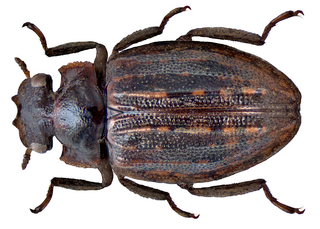
Spercheus is a genus of aquatic beetles which are placed in a family of their own, Spercheidae within the Hydrophiloidea. About 20 species are known from around the world except the Nearctic with the majority being from the Oriental and Afrotropical Realms.

The Hydroscaphidae are a small family of water beetles known commonly as skiff beetles. As of 2010, there are 23 species in the family. Several are recently described.

Hydrophilidae, also known colloquially as water scavenger beetles, is a family of beetles. Aquatic hydrophilids are notable for their long maxillary palps, which are longer than their antennae. Several of the former subfamilies of Hydrophilidae have recently been removed and elevated to family rank; Epimetopidae, Georissidae, Helophoridae, Hydrochidae, and Spercheidae. While the majority of hydrophilids are aquatic, around a third of described species are terrestrial, mostly belonging to the subfamily Sphaeridiinae.

Myxophaga is the second-smallest suborder of the Coleoptera after Archostemata, consisting of roughly 65 species of small to minute beetles in four families. The members of this suborder are aquatic and semiaquatic, and feed on algae.
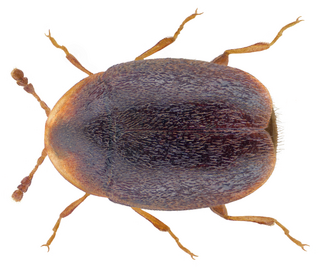
Corylophidae is a family of minute hooded beetles, sometimes called minute fungus beetles, in the superfamily Coccinelloidea. There are about 18 genera and at least 120 described species in Corylophidae. They feed on microfungi such as molds, and are often found associated with bark, as well as in leaf litter and other decaying vegetation. In older literature, the family name was often given as Orthoperidae.

Hydrophiloidea, known as water scavenger beetles, is a superfamily of beetles. Until recently it included only a single family, the Hydrophilidae, but several of the subfamilies have been removed and raised to family rank. Hydrophiliidae remains by far the largest member of the group, with nearly 3,000 described species. The other families have no more than 400 species. The Histeroidea are closely related and sometimes considered part of a sensu lato Hydrophiloidea. The majority of the clade is aquatic, which is thought to be the ancestral ecology of the group, with some lineages like Sphaeridiinae becoming secondarily terrestrial. Modern representatives of the group first appeared during the Late Jurassic.
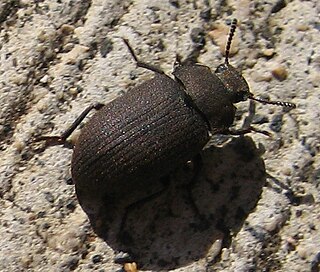
Opatrini is a tribe of darkling beetles (Tenebrionidae) in the subfamily Tenebrioninae.

Staphylininae are a subfamily of rove beetles. They contain the typical rove beetles with their long but fairly robust blunt-headed and -tipped bodies and short elytra, as well as some more unusually-shaped lineages.
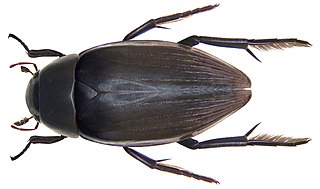
Hydrophilus is a genus of beetles in the family Hydrophilidae, the water scavenger beetles. There are 53 species in three subgenera in the genus: Hydrophilus, Dibolocelus, and Temnopterus.

Hydrophilinae is a subfamily of Hydrophilidae that contains five tribes in 33 genera after the classification was revised by Short and Fikáček in 2013.
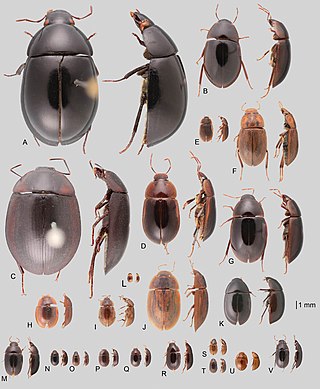
Acidocerinae is a subfamily in the family Hydrophilidae of aquatic beetles, and it contains over 500 species in 23 genera.

Chaetarthriinae is a subfamily in the family Hydrophilidae of aquatic beetles, and it contains 92 species in 8 genera.

Hydrobiomorpha is a genus of water scavenger beetles in the family Hydrophilidae. There are 56 extant described species in Hydrobiomorpha, along with several fossil species.

Xyletinini is a tribe of death-watch and spider beetles in the family Ptinidae. There are at least 10 genera and 70 described species in Xyletinini.
Lasiodermini is a tribe of death-watch and spider beetles in the family Ptinidae. There are at least 3 genera and 30 described species in Lasiodermini.

Dorcatomini is a tribe of beetles in the family Ptinidae. There are at least 3 genera and 50 described species in Dorcatomini.
Mauroniscidae is a family of cleroid beetles, formerly included in the family Melyridae. There are presently five or six genera and roughly 30 described species in Mauroniscidae, all of which are native to the Americas. Almost nothing is known about their biology.
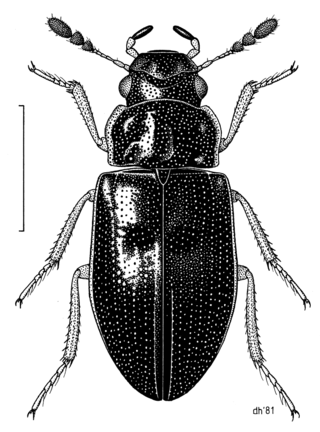
Horelophus walkeri is a small water scavenger beetle that is endemic to New Zealand. It is found in the South Island in the West Coast, Nelson, Buller and Marlborough regions. The preferred habitat of this species are the moss and crevices within the splash zone of waterfalls sourced from fast flowing, clear, cool waterways. The larvae of this species are carnivorous while the adults are herbivores or scavengers. In 2012 the Department of Conservation classified this beetle as Nationally Endangered.
Brownephilus is a genus of water scavenger beetles in the family Hydrophilidae containing two described species. Brownephilus was formerly a subgenus of Hydrobiomorpha and was elevated to genus by Andrew E.Z. Short in 2010.
Protistolophus spangleri is a species of water scavenger beetles in the family Hydrophilidae and the only species in the genus Protistolophus. Protistolophus spangleri was described as a new species and genus by Andrew E.Z. Short in 2010. The species is known only from Venezuela.















